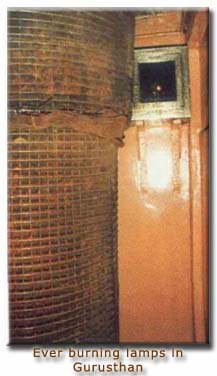Gurusthan
“In human life, the Guru’s place is prominent.
By keeping utmost faith in the Guru alone
everything is obtained.
A devotee’s entire strength is due to his Guru.
Devotion to the Guru is superior to
devotion to gods and goddesses.
The Guru is the Supreme Being. ”
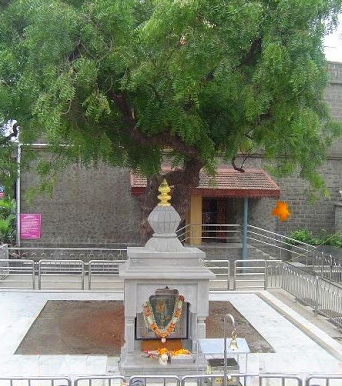
Shri Sai Baba
Gurusthan means “place of the Guru”. It is both where Baba spent most of his time when he first came to Shirdi, and also where, according to Baba, the tomb of his own Guru is located by the neem tree. Gurusthan is therefore one of the most important places in Shirdi.. From underneath the NEEM tree there is an underground tunnel or passage leading to the place of Dwarkamai as told by an old lady.
Once when some villagers were digging the foundations for Sathe Wada just behind the neem tree, they came across some bricks in the soil and what looked like the opening of a tunnel. Uncertain whether to proceed or not, they asked Baba what they should do. He told them that this was the site of the tombs of his ancestors and that it would be better not to disturb them.
There are several references to Baba’s Guru recorded in the literature, but they are somewhat enigmatic, and it is not clear whether he was referring to a Guru in his present lifetime, or a previous one.
The first thing that catches the devotee’s eye at Gurusthan is the huge neem tree. This tree gave shelter to Baba for a few years when he stayed beneath it. Neem has many medicinal properties, though its leaves are notoriously bitter. However, some people once reported that the leaves of one of the branches tested sweet. For them it was a sign of Baba’s grace; others see it as evidence of the tree’s exceptional sanctity.
One incidence concerning the neem tree illustrates how practical and down-to-earth Baba could be. In the early 1900s, after Baba had moved to the mosque, construction work on Sathe Wada was hampered by a long branch of the tree. However, nobody wanted to remove it, as this tree had been sanctified by Baba’s stay under it. When Baba was approached for his advice he told the villagers, “Cut off however much is interfering with the construction. Even if it is our own foetus which is lying across the womb, we must cut it !”. But despite this clear instruction from Baba, none dared to meddle with the tree. Eventually Baba himself climbed up and lopped off the branch.
Another reason for the villagers’ reluctance to prune the tree may have been that some time previously a boy had climbed the tree to trim it, and had fallen to the ground and died. At that moment, Baba, who was in the mosque, sounded a note of distress, blowing shankha (the sound a conch shell makes when blown into) with his cupped hands. Baba sometimes did this when a person was in great danger, although he could not have “seen” from the mosque what was occurring at Gurusthan. Villagers linked the boy’s death with his attempt to cut the tree, and became afraid to do anything to it that might have been a sacrilege.
Today at Gurusthan, in addition to the neem tree, there is a pair of marble padukas on a pedestal, a ‘Shivalinga’ and a statue of Baba. The statue, carved by the grandson of the sculptor of the Samadhi Mandir statue, was donated by Y. D. Dave and installed in 1974; the other things were set up in Baba’s time. The unveiling ceremony was done by Saint Shri Parnerkar Maharaj.
The padukas were the initiative of a couple of devotees from Mumbai (Bombay). During their visit to Shirdi they became friendly with two local devotees, G. K. Dixit (not to be confused with H. S. “Kakasaheb” Dixit) and Sagun Meru Naik. As they were sitting talking one day, they all felt it would be good if there were some kind of memorial to Baba’s advent in Shirdi and his stay under the neem tree. They first thought of laying some padukas made of rough stone. Then one of them suggested that if he put the proposal to his employer, Dr. Ramrao Kothare, he would probably be willing to sponsor something more elegant – as indeed he was. Dr. Kothare gladly came to Shirdi from Bombay, drew up a plan for them and showed it to Upasani Baba. Sri Upasani made some improvements adding a conch, lotus, Mahavishnu wheel – and suggested that two of his Sanskrit slokas extolling the tree’s greatness and Baba’s powers be inscribed on the padukas’ pedestal. These translate as follows :
“ I bow to Lord Sainath, who by his constant stay at the
foot of the neem tree – which although bitter and
unpleasant, was yet oozing nectar – made it better than
the wish-fulfilling tree. I bow to Lord Sainath, who
always takes delight in resting under the neem tree and
bestowing material and spiritual prosperity upon his
devotees who lovingly attend on him.”
The padukas were made in Bombay and sent to Shirdi. When they arrived, Baba commented that they were “Allah’s padukas” and should be placed in Gurusthan on a particular day. The padukas were duly installed in a solemn ceremony on the August full moon day (15th) of 1912, having been carried in procession from Khandoba Temple (it was G. K. Dixit who bore them on His head).
At this time, arati was already being performed every day in Sathe Wada and Dixit Wada. With the installation of the padukas, a third arati was started, at Gurusthan and G. K. Dixit was employed to officiate.
A few months after their installation the padukas were damaged by a lunatic who also destroyed some of Shirdi’s temple idols. The devotees were very distressed, believing it augured ill. Baba, however, took the matter casually and told them simply to repair the crack with cement and undertake a poor-feeding. In fact, the broken padukas were later replaced and the originals are said to be in the pedestal underneath.
Once when some villagers were digging the foundations for Sathe Wada just behind the neem tree, they came across some bricks in the soil and what looked like the opening of a tunnel. Uncertain whether to proceed or not, they asked Baba what they should do. He told them that this was the site of the tombs of his ancestors and that it would be better not to disturb them.
There are several references to Baba’s Guru recorded in the literature, but they are somewhat enigmatic, and it is not clear whether he was referring to a Guru in his present lifetime, or a previous one.
The first thing that catches the devotee’s eye at Gurusthan is the huge neem tree. This tree gave shelter to Baba for a few years when he stayed beneath it. Neem has many medicinal properties, though its leaves are notoriously bitter. However, some people once reported that the leaves of one of the branches tested sweet. For them it was a sign of Baba’s grace; others see it as evidence of the tree’s exceptional sanctity.
One incidence concerning the neem tree illustrates how practical and down-to-earth Baba could be. In the early 1900s, after Baba had moved to the mosque, construction work on Sathe Wada was hampered by a long branch of the tree. However, nobody wanted to remove it, as this tree had been sanctified by Baba’s stay under it. When Baba was approached for his advice he told the villagers, “Cut off however much is interfering with the construction. Even if it is our own foetus which is lying across the womb, we must cut it !”. But despite this clear instruction from Baba, none dared to meddle with the tree. Eventually Baba himself climbed up and lopped off the branch.
Another reason for the villagers’ reluctance to prune the tree may have been that some time previously a boy had climbed the tree to trim it, and had fallen to the ground and died. At that moment, Baba, who was in the mosque, sounded a note of distress, blowing shankha (the sound a conch shell makes when blown into) with his cupped hands. Baba sometimes did this when a person was in great danger, although he could not have “seen” from the mosque what was occurring at Gurusthan. Villagers linked the boy’s death with his attempt to cut the tree, and became afraid to do anything to it that might have been a sacrilege.
Today at Gurusthan, in addition to the neem tree, there is a pair of marble padukas on a pedestal, a ‘Shivalinga’ and a statue of Baba. The statue, carved by the grandson of the sculptor of the Samadhi Mandir statue, was donated by Y. D. Dave and installed in 1974; the other things were set up in Baba’s time. The unveiling ceremony was done by Saint Shri Parnerkar Maharaj.
The padukas were the initiative of a couple of devotees from Mumbai (Bombay). During their visit to Shirdi they became friendly with two local devotees, G. K. Dixit (not to be confused with H. S. “Kakasaheb” Dixit) and Sagun Meru Naik. As they were sitting talking one day, they all felt it would be good if there were some kind of memorial to Baba’s advent in Shirdi and his stay under the neem tree. They first thought of laying some padukas made of rough stone. Then one of them suggested that if he put the proposal to his employer, Dr. Ramrao Kothare, he would probably be willing to sponsor something more elegant – as indeed he was. Dr. Kothare gladly came to Shirdi from Bombay, drew up a plan for them and showed it to Upasani Baba. Sri Upasani made some improvements adding a conch, lotus, Mahavishnu wheel – and suggested that two of his Sanskrit slokas extolling the tree’s greatness and Baba’s powers be inscribed on the padukas’ pedestal. These translate as follows :
“ I bow to Lord Sainath, who by his constant stay at the
foot of the neem tree – which although bitter and
unpleasant, was yet oozing nectar – made it better than
the wish-fulfilling tree. I bow to Lord Sainath, who
always takes delight in resting under the neem tree and
bestowing material and spiritual prosperity upon his
devotees who lovingly attend on him.”
The padukas were made in Bombay and sent to Shirdi. When they arrived, Baba commented that they were “Allah’s padukas” and should be placed in Gurusthan on a particular day. The padukas were duly installed in a solemn ceremony on the August full moon day (15th) of 1912, having been carried in procession from Khandoba Temple (it was G. K. Dixit who bore them on His head).
At this time, arati was already being performed every day in Sathe Wada and Dixit Wada. With the installation of the padukas, a third arati was started, at Gurusthan and G. K. Dixit was employed to officiate.
A few months after their installation the padukas were damaged by a lunatic who also destroyed some of Shirdi’s temple idols. The devotees were very distressed, believing it augured ill. Baba, however, took the matter casually and told them simply to repair the crack with cement and undertake a poor-feeding. In fact, the broken padukas were later replaced and the originals are said to be in the pedestal underneath.
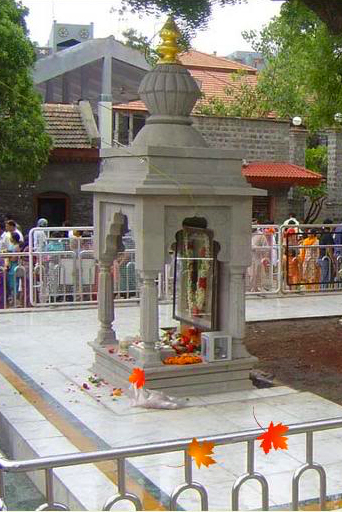
Megha was a simple, austere Gujarathi Brahmin, who worshipped Shiva but saw his chosen deity in Sai Baba. Characteristically, Baba encouraged his devotee to maintain his worship of Shiva. One day Baba blessed him with a vision, appearing to him early one morning telling him to draw a trident (emblem of Shiva) and leaving behind a few grains of rice (the kind that are used in puja). When Megha went to him in the mosque Baba emphatically confirmed the instruction, and Megha returned to his room to carry it out. The next day someone presented a shivaling to Baba. Baba called Megha over saying, “Look, Shiva has come for you!” and giving the shivaling to Megha, told him to use it for worship.
At that time, Megha was staying in Dixit Wada. He took the shivaling home with him and showed it to H. S. Dixit. Dixit then disclosed that he had just had a vision of the very same shivaling arriving at the wada! Megha worshipped this shivaling with great dedication until the end of his days. When the padukas were to be installed, the devotees wanted to take the opportunity to put a shivaling there too. If there was a tomb here as Baba had said, then according to Hindu custom, it required a shivaling. They therefore asked Baba’s permission, and he said they could use the shivaling that Megha had worshipped until his death at the beginning of that year. So the shivaling that we see there now is the same one that Baba lovingly handed over to Megha.
During Baba’s lifetime, Gurusthan was completely open and looked quite different from the fully paved and enclosed area it has now become. Shri Sai Baba said that whoever burns incense and cleans here on Thursdays and Fridays would be blessed by Allah (Thursday is sacred to Hindus, and Friday to Muslims). We assume that out of love and respect for his Guru, Baba wishes the place to be venerated and kept clean.
A small dhuni on a stand is kept in front of the shrine here. Until recently it was kindled every day by embers brought from the main dhuni at the mosque, but this is now done only on Thursdays and Fridays.
Finally, before we leave Gurusthan, let us return to the might neem tree. Since the 1980’s more and more devotees have started doing pradakshina around the tree (and thereby the tomb). Now, one can often see large numbers of people going around throughout the day and night. Others find that Gurusthan is a powerful place to sit quietly. Some people regard the tree as a symbol of the Guru’s grace under which humanity may take shelter and protection. Indeed, Sai Baba once commented that his devotees are simply resting in the shade of the neem tree while he bears the brunt of their deeds.
Takia
Just across from Gurusthan, to the east of Dixit Wada opposite the neem tree, near to where an open theatre has recently been built, there used to be a takia or small shed. A takia is a resting place for visiting fakirs and Baba also sometimes spent the night here when he first came to Shirdi.
Sai Baba had a great love of music and dance. In his early days he would often go by the takia and sing devotional songs, usually in Arabic or Persian, or the (Hindi) songs of Kabir. His voice is described as “very sweet and appealing”. Sometimes he would put on bells and anklets and dance around in ecstasy while singing, probably in the company of visiting fakirs who were putting up here for a night or two. Even though the takia is not there any more, one can easily imagine the scenes of ecstatic devotion that were creatively enacted here during the night hours.
GURU PADUKA'S STHAN OR GURUSTHAN & TAKIA
Baba first manifested Himself for the sake of His Bhaktas, under the neem (margosa) tree as a young lad of sixteen. The villagers were amazed to see His divine form and the hard penance that He did. He did not go to anybody's house and was oblivious of heat and rain and was in divine bliss. One day Lord Khandoba possessed the body of some devotee and the people asked him to inquire about this lad and whence He came from. Lord Khandoba asked them to bring a pickaxe and dig in a particular place. This was done. The cellar was 10’ in length and 10’ in breadth and 12’ high. Inside it they found a paat (flat stone). Under the flat stone were found four burning lamps and a corridor leading to a cellar where 'cow-mouth' shaped structures, a Jaap Mala (rosary). Khandoba said this lad practiced penance for 12 years here. The people began to question the lad about this. He diverted the question by telling them that this was His Guru's place and requested them to guard it well. To prove his point he placed his right hand on a branch of the Neem tree. That was the branch facing the east and said “This is the truth, and from today the bitterness of this side of the Neem will disappear.” Thus it came to pass that the leaves on the right side are not bitter. Thbe villagers then covered the portion that was dug. They placed the mud over as it was before. Then Baba said, “Anyone who applies slurry of cow dung on this area, on Thursday and Friday, and offers incense sticks, will be benefited greatly”. Devotees offer incense sticks in Gurusthan even to this day. (Ref. ESS, Ch.IV). Nobody knows who was Baba's Guru and His holy waten. As a reminiscence of Baba's first appearance in this place, devotees installed Padukas there.
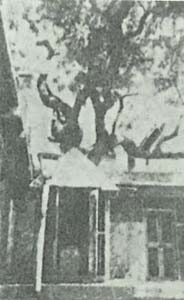
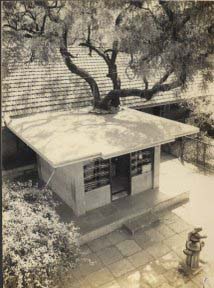
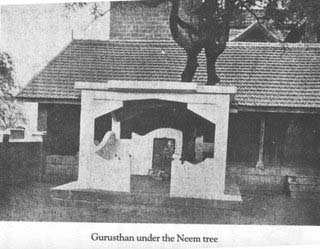
In the 1920’s the Gurusthan was a small temple facing west adjacent to the Neem tree. On Ashwin Shudh Dashmi, Shake 1863 (30th September 1941) a beautiful temple was reconstructed. This west facing temple was on a small platform, about 1’ high. It had bass relief peacocks, and flowers, and painted with delightfully bright colours. There was a small Kalasha on top.
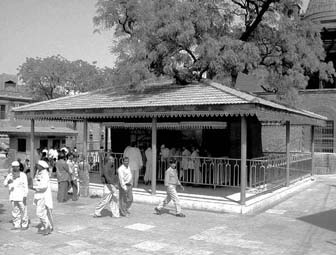
In 1974, this small shrine was enclosed in a bigger temple. Baba’s idol was placed to the right of the small shrine, while the Neem tree was to the left of it. The marble padukas were in front of the Neem tree on a pedestal. Around April month of 2007, the Neem tree was drying up. Hence, the Shirdi Saibaba Sansthan got the horticulture department to treat it. Thus, the old Gurusthan structure had to be removed, so that the roots could get adequate supply of oxygen, nutrients and water. As Guru Poornima was fast approaching the present Gurusthan was constructed.
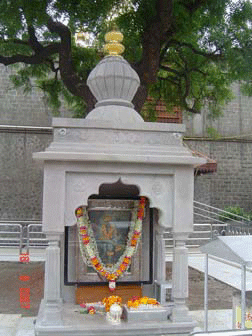
THE SMALL DHUNI MAA This small Dhuni Maa is present in front of Gurusthan. Shirdi Saibaba Sansthan has made arrangement to offer Dhoop on every Thursday and Friday. Saibaba has assured that whoever offers Dhoop on Thursday’s and Friday’s, their wishes will be fulfilled. Earlier, the sacred fire was brought from Dwarakamai to Gurusthan everyday and Dhuni was lit by the Sansthan Poojari. Now this is being done only on Thursday’s and Friday’s
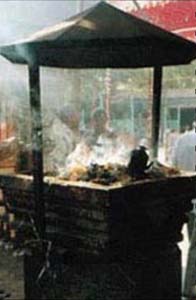
THE SACRED NEEM TREE Just as the Audumbar and Aswatha trees are considered sacred, Baba held this Neem tree to be sacred. This blessed tree was there already, waiting for Baba to sit under her shade. It is believed that the Neem tree is the abode of the Goddesses and it is also referred to as “Neenari”. In Chaitra Maas after Amavasya Durga and Maha Kali reside on the tree. In 'Sai Mahima Sthothra', Upasani refers to this Neem tree as surpassing the 'Kalpa Vriksha' and showering Ambrosia of Baba's grace. Because Baba constantly sat under this Neem tree when He first came to Shirdi. The leaves are oozing nectar on account of the healing properties. Hence devotees worship this tree and eat its leaves mixed with pepper and sugar, as it has curative properties. Many devotees are relieved of their ailments by eating the leaves of this tree. 108 Pradakshina of Gurusthan is done by many devotees early in the morning, and at other times for destruction of their Karma, spiritual enlightenment and fulfillment of their wishes.
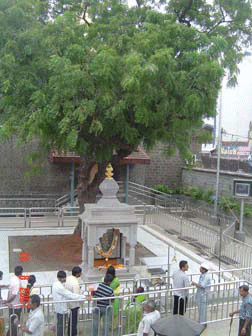
BABA’S IDOL This Marble idol is about 3’ in height, and is of “Baba sitting on the stone” posture. On Gurupoornima 1974 pratishta of this statue took place in Gurusthan with due formalities. Yashvanthrao D. Dave, a staunch devotee of Baba from Mumbai, donated the statue which was sculpted by Harish Balaji Thalim (son of late Balaji Vasanth Thalim, who had sculpted the Idol of Baba for the Samadhi Mandir).
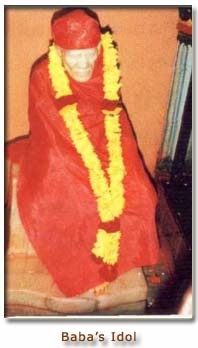
In the year 2007, this idol was covered from head to toe and placed in the Museum to rejuvenate the Neem tree that was drying up due to lack of adequate supply of oxygen, nutrients and water. The Gurusthan was reconstructed and Baba’s Idol moved to Museum.
BABA'S ORIGINAL PORTRAIT A beautiful original portrait of Baba was installed, inside the small temple during Baba's lifetime. Arati was performed twice a day by Bapu Saheb Jog. This was later discontinued on Baba's advice. This photo is noteworthy for giving Sakshatkar and darshan of the Ishta Devata to many devotees. On 30th September 1952 which happened to be the 3rd day of the festival of Baba’s 34th Mahasamadhi, this original photograph was changed. Saibaba Sansthan Trust felt that the photograph was old. So it was replaced by a photograph donated by Shri.Narayanrao Devhare. At 11 am with due rituals the sthapana of the photograph was done by Shri.Vasantrao Narayan Gowrakshakar (Refer: Sai Leela Magazine. Ank 4. Year 29 October, November December 1952). Alankar is done by the Pujari in charge daily in the morning and bhog is offered at 11:30 am and in the evenings after Dhoop Aarti.
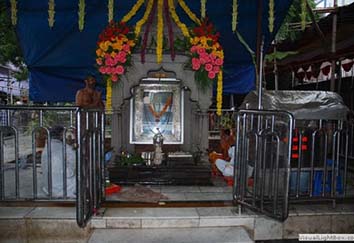
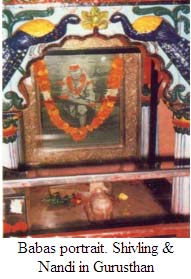
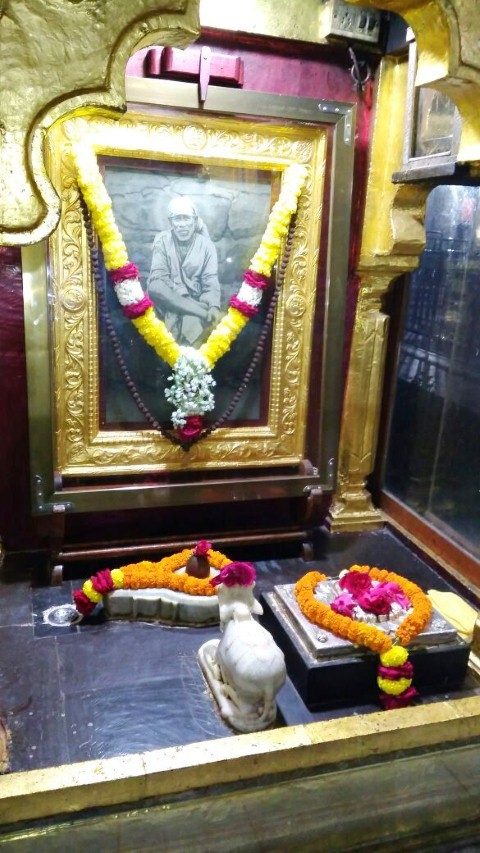
SHIVA LINGA
In front of Baba's photograph is this Shiva Linga. The Shiva Linga faces north, while the Nandi faces east and is in front of Baba’s photograph. Baba blessed Megha by giving him Sakshatkar and then gave him this Shiva LInga and a Nandi. Baba bestowed this favour on Megha by presenting him with a Shiva Linga following His order to draw a trident (Ref. ESS, Ch. XXVIII). Megha thus realised that Baba was none other than his Ishta Dev, Shiva.
Following Mangal Snan of the Baba's statue, this Shiva Linga is bathed and adorned. On Maha Shivratri, Rudrabhishek and elaborate rituals are done at the time of Lingodbhav. This Shiva Linga was installed in 1912 after Megha passed away.
BABA'S PADUKAS
In Chapter 5 of the Shri Sai Satcharita the story of the Padukas are given. These marble Padukas are placed on a pedestal.
The Story of Padukas (foot-prints) under the Neem Tree
A devotee of Akkalkot Maharaj by name Bhai Krishnaji Alibagkar worshipped the photo of Akkalkot Maharaj. He once thought of going to Akkalkot (Sholapur District), taking the darshana of the Padukas (foot-prints) of the Maharaj and offering his sincere worship there; but before he could go there, he got a vision in his dream. Akkalkot Maharaj appeared in the vision and said to him - "Now Shirdi is my resting place, go there and offer your Worship." So Bhai changed his plan and came to Shirdi, worshipped Baba, stayed there for six months and was happy. As a reminiscence of this vision etc., he prepared the Padukas and installed them on an auspicious day of Shravan, Shaka 1834 (1912 A.D.) under the Neem tree with due ceremonies and formalities, conducted by Dada Kelkar and Upasani. One Dixit Brahmin was appointed for worship, and the management was entrusted to devotee Sagun.
Complete Version of this Story
Mr. B.V. Deo, Retired Mamalatdar of Thana, and a great devotee of Sai Baba, made enquired about this matter with Sagun Meru Naik and Govind Kamlakar Dixit and has published a full version of the Padukas in Sai Leela Vol. 11, No. 1, page 25. It runs as follows:
In 1834 Shaka (1912 A.D.) one Doctor Ramarao Kothare of Bombay came to Shirdi for Baba’s darshana. His compounder; and his friend, Bhai Krishnaji Alibagkar, accompanied him. The compounder and Bhai became intimate with Sagun Meru Naik and G.K. Dixit. While discussing things, these persons thought that there must be some memorial of the fact of Sai Baba’s first coming to Shirdi and sitting under the holy Neem tree. They thought of installing Baba’s Padukas there and were going to make them of some rough stones. Then Bhai’s friend, the compounder, suggested that if this matter be made known to his master, Dr. Ramarao Kothare, who would prepare nice Padukas for this purpose. All liked the proposal and Dr. Kothare was informed of it. He came to Shirdi and drew a plan of the Padukas. He went to Upasani Maharaj in Khandoba’s temple, and showed him his plan. The latter made many improvements, drew lotuses, flowers, conch, disc, man etc., and suggested that the following SHLOKA (verse) regarding Neem tree’s great ness and Baba’s Yogi powers be inscribed. The verse was as follows:
"Sada Nimbarvrikshasya mooladhiwasat,
Sudhasravinam tiktamapi -apriyam tam,
Tarum Kalpavrikshadhikam sadhayantam
Namameeshwaram Sadgurum Sai Natham"
Upasani’s suggestions were accepted and carried out. The Padukas were made in Bombay and sent to Shirdi with the compounder. Baba said that they should be installed on the Pournima (15th) of Shravan. On that day at 11 a.m., G.K. Dixit brought them on his head from Khandoba’s temple to the Dwarkamai (Masjid) in procession. Baba touched the Padukas, saying that these are the feet of the Lord and asked the people to instal them, under foot of the Neem tree. A day before, one Parsi devotee of Bombay named Pastha Shet sent Rs.25/- by money order.
Baba gave this sum for the installation of the Padhukas. The total expense of installation came up to Rs.100/- out of which Rs.75/ - were collected by subscriptions. For the first 5 years, G.K. Dixit worshipped the Padukas daily and then Laxman Kacheshwar Jakhadi did this. In the first five years, Dr. Kothare sent Rs. 2 per month for lighting and he also sent the railing round the Padukas. The expense of bringing the railing from the station to Shirdi (Rs. 7-8-0) (presently Rs.7.50p) and roofing was paid by Sagun Meru Naik. During later years, Jakhadi (Nana Pujari) did the worship and Sagun Meru Naik offered the naivaidya and lights the evening lamps. Bhai Krishnaji was orginally a devotee of Akkalkot Maharaj. He had come to Shirdi at the installation of the Padukas, in Shaka 1834 on his way to Akkalkot. He wanted to go to Akkalkot after taking the darshana of Baba. He asked Baba’s permission for this. Baba said - "Oh, what is there in Akkalkot? Why do you go there? The incumbent Maharaj of that place is here, Myself." Hearing this Bhai did not go to Akkalkot. He came to Shirdi off and on, after the installation of the Padukas.
Now the Sansthan pujari does abhishek and alankar daily.
THE EVER BURNING LAMPS
The two ever burning lamps were placed on the wall on either side of the Neem tree. They were enclosed in a silver casing with a glass door. They were placed at a height of about 5’ so that the Pujari could attend to them easily. Daily the wicks were trimmed, replenished with oil, and new wicks used whenever necessary. This was done without allowing the Jyothi (Lit end) to be extinguished, as the Jyothi is burning since Baba’s time.
Following the installation of the Padukas, Dr. Kothari sent Rs.2/- per month for lighting the lamps. Then Shagun Meru did the service. Now the Sansthan does this (Ref. ESS, Ch. V).
Since Guru Poornima of 2007, there is only one small “Ever Burning Lamp”. This lamp is kept in the right hand corner and towards the front of Baba’s photograph. This photograph gives a view of the interior of the Gurusthan in days gone by. The devotees can see for themselves what it looks like now.
